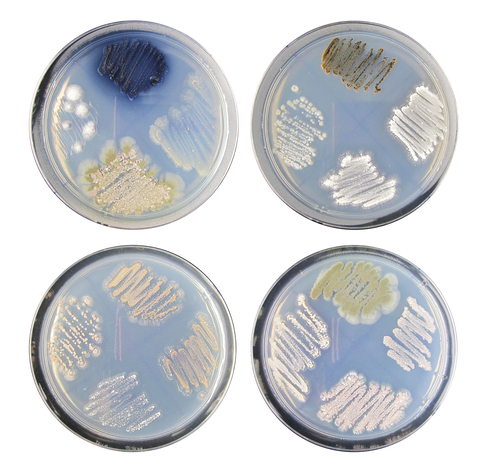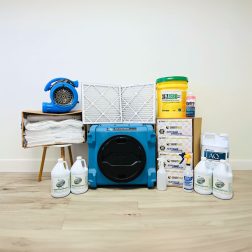Mold Resources
What is Actinobacteria?
Actinobacteria are gram-positive bacteria found in soil, water, and even living organisms. They form colonies with thread-like structures called hyphae, resembling mold in appearance and behavior. While many actinobacteria species are beneficial, some can become harmful when they grow indoors, especially after water damage.
Is Actinobacteria Good or Bad?
Actinobacteria can be both. Beneficial species, like Streptomyces, produce antibiotics like streptomycin and tetracycline. However, some actinobacteria in water-damaged environments have been linked to decreased lung function and asthma-like symptoms. Exposure has also been associated with diseases like Chronic Inflammatory Response Syndrome (CIRS) and Extrinsic Allergic Alveolitis (EAA), leading to flu-like symptoms and chronic respiratory issues. Vulnerable groups, including those with weakened immune systems, may experience more severe effects.
What Disease Does Actinobacteria Cause?
Certain species of Actinobacteria can cause serious health problems. Actinomyces species are responsible for actinomycosis, a chronic infection that causes painful swelling, abscesses, and tissue damage. Another genus, Nocardia, can lead to nocardiosis, a lung infection that may spread to other organs, particularly in individuals with compromised immune systems.
What Happens When Actinobacteria Grow in a Home?
When Actinobacteria grow indoors, especially in moist environments, they can impact both the home’s structure and its air quality. Key issues include:
Impact on Indoor Air Quality: Actinobacteria release airborne spores and microbial volatile organic compounds (MVOCs), degrading air quality.
Development of Biofilms: These bacteria can form biofilms—slimy layers of bacterial colonies that adhere to surfaces in areas with excessive moisture. These biofilms often harbor other microorganisms like mold.
Potential for Infections: The presence of actinobacteria indoors can cause infections, particularly in individuals with weakened immune systems.
Chronic Immune Strain: Continuous exposure to actinobacteria can strain the immune system, leading to chronic inflammation and allergic reactions.

Where Does Actinobacteria Grow in a Home?
Actinobacteria, particularly actinomycetes, thrive in environments with moisture, organic material, and oxygen. Homes affected by water damage, leaks, or high humidity provide ideal conditions for their growth. Common areas for actinobacteria to flourish include basements, attics, and around leaky windows. They can grow on materials like drywall, wood, and insulation, often co-colonizing with mold. Actinobacteria can compromise a building’s structural integrity and spread harmful spores into the air.
How to Get Rid of Actinobacteria in a House
Removing actinobacteria depends on the severity of the contamination:
Small Issues: For minor contamination on nonporous surfaces like metal, use a botanical cleaner like Benefect Decon 30. Spray the surface, let it sit for 30 seconds, and wipe with a microfiber cloth. For semi-porous surfaces like hardwood, an abrasive technique is needed to remove the roots. Porous items like clothing may need to be discarded, as they are difficult to remediate.
Larger Issues: For significant contamination, hire a professional remediation company that prioritizes health and uses a thorough protocol. This includes eliminating sources of contamination, addressing moisture issues, and ensuring all bacteria, mold, and toxins are eradicated.
After remediation, deep clean the area, and don’t forget to service the HVAC system to ensure no contamination remains.
How to Prevent Actinobacteria
Preventing actinobacteria growth focuses on moisture control and creating an inhospitable environment for bacteria.
Key steps include:
Fix leaks immediately.
Keep indoor humidity between 35-50% using dehumidifiers.
Ventilate moisture-prone areas like bathrooms and kitchens.
Dry out water-damaged areas within 24-48 hours.
Remove and replace waterlogged materials like drywall and insulation.
Regularly clean with botanical products and HEPA vacuum cleaners.
Use air purifiers to capture airborne spores and bacteria.
Inspect crawl spaces and attics for moisture buildup.
Store organic materials like paper in dry, well-ventilated areas.
Upgrade HVAC filters to the highest MERV rating your system can handle, and maintain the system regularly.
Taking these steps will reduce the risk of actinobacteria thriving in your home, protecting both your indoor air quality and your health.
Showing all 3 results
-

HomeCleanse DIY
All the equipment and materials we use to remediate your home, plus consultation and support...
-
$5,995.00 – $9,995.00 SHOP NOW -

Mold & Bacteria Contents Cleaning
Remove harmful pollutants that accumulate in the dust of your home. (Options available for renters...
-
$99.00 – $349.00 SHOP NOW -

HomeCleanse Cleaning
Take your cleaning to the next level buying all the tools we use to keep...
-
$299.00 – $549.00 SHOP NOW
Resources:
Still Have Questions?
A member of our team is here to help! Click on “Get Started ➤” below to book a consultation with a member of the HOMECLEANSE team. We have a few quick questions that will help us put together a roadmap to solve or prevent all of your mold problems.
Two minutes of your time could lead to better health for you and your family.
